
List of planetary nebulae
Encyclopedia
Northern Hemisphere
| Image | Name | Messier Catalogue | NGC New General Catalogue The New General Catalogue of Nebulae and Clusters of Stars is a well-known catalogue of deep sky objects in astronomy. It contains 7,840 objects, known as the NGC objects... |
Other designation | Date discovered | Distance (kly Light Years Light Years is the seventh studio album by Australian recording artist Kylie Minogue. It was released on 25 September 2000 by Parlophone and Mushroom Records. The album's style was indicative of her return to "mainstream pop dance tunes".... ) |
Apparent Magnitude (visual) | Constellation |
|---|---|---|---|---|---|---|---|---|
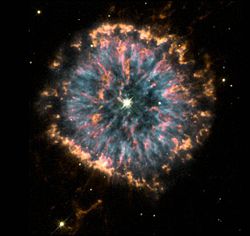 |
NGC 6751 NGC 6751 NGC 6751 is a planetary nebula in the constellation Aquila. The nebula is estimated to be around 0.8 light-years in diameter. The star at the centre of the nebula has a surface temperature of approximately 140,000 K. It has been calculated to be roughly 6,500 light-years away from Earth... |
6.5 | 15.8 | Aquila | ||||
| NGC 6210 NGC 6210 NGC 6210 is a planetary nebula located in the constellation Hercules.-External links:*... |
4.7 | 9.3 | Hercules | |||||
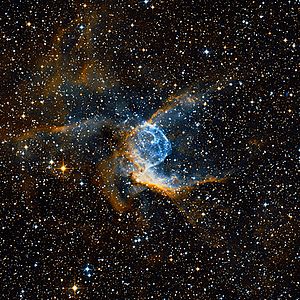 |
Thor's Helmet NGC 2359 NGC 2359 is an emission nebula in the constellation Canis Major. The nebula is approximately 15,000 light-years away and 30 light years in size. Known as a Wolf-Rayet star, the central star is an extremely hot giant thought to be in a brief, pre-supernova stage of evolution... |
NGC 2359 NGC 2359 NGC 2359 is an emission nebula in the constellation Canis Major. The nebula is approximately 15,000 light-years away and 30 light years in size. Known as a Wolf-Rayet star, the central star is an extremely hot giant thought to be in a brief, pre-supernova stage of evolution... |
15 | 11.45 | Canis Major | |||
 |
NGC 40 NGC 40 NGC 40 is a planetary nebula discovered by W.F.Herschel Nov 25 1788, and is composed of hot gas around a dying star. The star has ejected its outer layer which has left behind a smaller, hot star with a temperature on the surface of about 50,000 degrees... |
1788 | 3.5 | 11.4 | Cepheus | |||
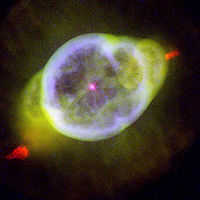 |
Ghost of Jupiter | NGC 3242 NGC 3242 NGC 3242 is a planetary nebula located in the constellation Hydra.William Herschel discovered the nebula on February 7, 1785, and cataloged it as H IV.27... |
1785 | 1.4 | 8.6 | Hydra | ||
 |
Blinking Planetary | NGC 6826 NGC 6826 NGC 6826 is a planetary nebula located in the constellation Cygnus. It is commonly referred to as the "blinking planetary", although many other nebulae exhibit such "blinking". When viewed through a small telescope, the brightness of the central star overwhelms the eye when viewed directly,... |
2.0 | 8.8 | Cygnus | |||
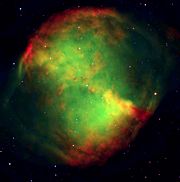 |
Dumbbell Nebula Dumbbell Nebula The Dumbbell Nebula is a planetary nebula in the constellation Vulpecula, at a distance of about 1,360 light years.... |
M27 Dumbbell Nebula The Dumbbell Nebula is a planetary nebula in the constellation Vulpecula, at a distance of about 1,360 light years.... |
NGC 6853 | 1764 | 1.36 | 7.5 | Vulpecula | |
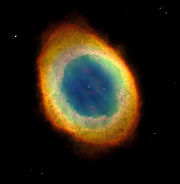 |
Ring Nebula Ring Nebula The famously named "Ring Nebula" appears in the northern constellation of Lyra and is located in the Carina–Sagittarius Arm... |
M57 Ring Nebula The famously named "Ring Nebula" appears in the northern constellation of Lyra and is located in the Carina–Sagittarius Arm... |
NGC 6720 Ring Nebula The famously named "Ring Nebula" appears in the northern constellation of Lyra and is located in the Carina–Sagittarius Arm... |
1779 | 2.3 | 9 | Lyra | |
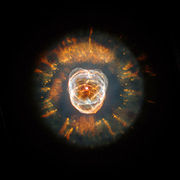 |
Eskimo Nebula Eskimo Nebula The Eskimo Nebula , also known as the Clownface Nebula or Caldwell 39, is a bipolar double-shell planetary nebula . It was discovered by astronomer William Herschel in 1787. The formation resembles a person's head surrounded by a parka hood. It is surrounded by gas that composed the outer layers of... |
NGC 2392 | 1787 | 2.9 (approx.) | 10.1 | Gemini | ||
| Bug Nebula | NGC 6302 NGC 6302 NGC 6302 is a bipolar planetary nebula in the constellation Scorpius. The structure in the nebula is among the most complex ever observed in planetary nebulae... |
1888 (prior to) | 3.4 ± 0.5 | 7.1B | Scorpius | |||
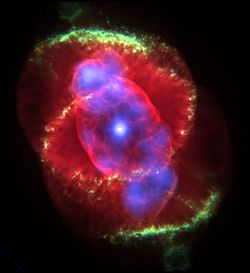 |
Cat's Eye Nebula Cat's Eye Nebula The Cat's Eye Nebula is a planetary nebula in the constellation of Draco. Structurally, it is one of the most complex nebulae known, with high-resolution Hubble Space Telescope observations revealing remarkable structures such as knots, jets, bubbles and sinewy arc-like features... |
NGC 6543 | 1786 | 3.3 ± 0.9 | 9.8B | Draco | ||
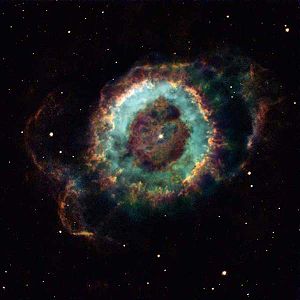 |
Little Ghost Nebula Little Ghost Nebula Little Ghost Nebula is a planetary nebula in the Ophiuchus constellation. It was discovered by William Herschel.Round and planet-shaped, the nebula is also relatively faint. Planetary nebulae are not related to planets at all, but instead are created at the end of a sun-like star's life as its... |
NGC 6369 | 1800 (prior to) | 9.9 | Ophiuchus | |||
| Medusa Nebula Medusa Nebula The Medusa Nebula is a large planetary nebula in the constellation of Gemini on the Canis Minor border. It also known as Abell 21 and Sharpless 274. It was originally discovered in 1955 by UCLA astronomer George O. Abell, who classified it as an old planetary nebula... |
1955 | 1.0 (approx.) | 15.99 | Gemini | ||||
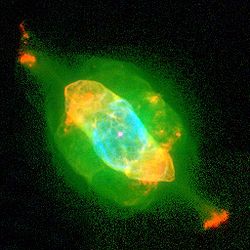 |
Saturn Nebula Saturn Nebula The Saturn Nebula is a planetary nebula in the constellation Aquarius. It was discovered by William Herschel on September 7, 1782, using a telescope of his own design in the garden at his home in Datchet, England, and was one of his earliest discoveries in his sky survey... |
NGC 7009 | 1782 | 3.0 (approx.) | 12.8 | Aquarius | ||
 |
NGC 7027 NGC 7027 NGC 7027 is a very young and dense planetary nebula located around away in the constellation Cygnus. It was discovered in 1878 by Édouard Jean-Marie Stephan, using the 31 inch reflector at Marseille Observatory. It is one of the smallest planetary nebulae, and by far the most extensively... |
1878 | 3.0 (approx.) | 10 | Cygnus | |||
 |
Helix Nebula Helix Nebula The Helix Nebula is a large planetary nebula located in the constellation Aquarius. Discovered by Karl Ludwig Harding, probably before 1824, this object is one of the closest to the Earth of all the bright planetary nebulae. The estimated distance is about 215 parsecs or 700 light-years... |
NGC 7293 | 1824 | 0.68 | 13.5 | Aquarius | ||
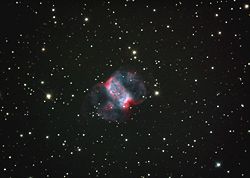 |
Little Dumbbell Nebula Little Dumbbell Nebula The Little Dumbbell Nebula, also known as Messier 76, NGC 650/651, the Barbell Nebula, or the Cork Nebula, is a planetary nebula in the constellation Perseus. It was discovered by Pierre Méchain in 1780 and included in Charles Messier's catalog of comet-like objects as number 76. It was first... |
M76 Little Dumbbell Nebula The Little Dumbbell Nebula, also known as Messier 76, NGC 650/651, the Barbell Nebula, or the Cork Nebula, is a planetary nebula in the constellation Perseus. It was discovered by Pierre Méchain in 1780 and included in Charles Messier's catalog of comet-like objects as number 76. It was first... |
NGC 650, NGC 651 | 1780 | 3.4 (approx.) | 10.1 | Perseus | |
| Owl Nebula Owl Nebula The Owl Nebula is a planetary nebula in the constellation Ursa Major. It was discovered by Pierre Méchain in 1781.... |
M97 Owl Nebula The Owl Nebula is a planetary nebula in the constellation Ursa Major. It was discovered by Pierre Méchain in 1781.... |
NGC 3587 | 1781 | 2.6 (approx.) | 9.9 | Ursa Major | ||
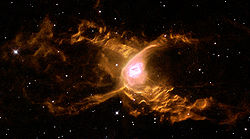 |
Red Spider Nebula | NGC 6537 NGC 6537 The Red Spider Nebula is a planetary nebula located in the constellation Sagittarius.The central white dwarf, the remaining compact core of the original star, produces a powerful and hot wind blowing with a speed of 300 kilometers per second, which has generated waves 100 billion kilometres high... |
1888 (prior to) | 3.9 (approx.) | 11.9 | Sagittarius | ||
 |
Twin Jet Nebula or Butterfly Nebula |
M2-9 | 1947 | 2.1 | 14.7 | Ophiuchus | ||
| Footprint Nebula | M1-92 M1-92 M1-92 is a planetary nebula. It was imaged by the Hubble Space Telescope in the 1990s. The bipolar planetary nebula has a particular form of twin lobes of material that emanates from a central star. Astronomers have dubbed this object as the Footprint Nebula.-External links:*... |
1946 | 15.0 (maximum) | 11.7 | Cygnus | |||
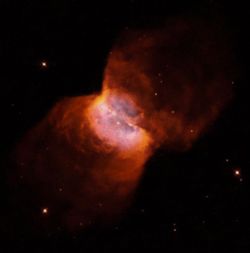 |
NGC 2346 NGC 2346 NGC 2346 is a planetary nebula near the celestial equator in the Monoceros constellation. It is bright and conspicuous and has been extensively studied... |
1802 | 3.9 (approx.) | 11.9 | Monoceros | |||
| Abell 39 Abell 39 Abell 39 is a low surface brightness planetary nebula in the constellation of Hercules. It is the 39th entry in George Abell's 1966 Abell Catalog of Planetary Nebulae of 86 old planetary nebulae which either Abell or Albert George Wilson discovered before August 1955 as part of the National... |
1955 | 6.8 (approx.) | 13.7 | Hercules | ||||
| Jones-Emberson 1 Jones-Emberson 1 Jones-Emberson 1 is a 14th magnitude planetary nebula in the constellation Lynx at a distance of 1600 light years. It is a larger planetary with low surface brightness. The 16.8-magnitude central star is very blue white dwarf.-Historic data:... |
PK 164+31.1 | 1939 | 1.6 (approx.) | 14.0 | Lynx | |||
| Lemon slice nebula Lemon slice nebula The Lemon slice nebula, or IC 3568, is a planetary nebula 1.3 kiloparsecs away in the constellation Camelopardalis .It has a diameter of 0.4 lightyears. The Lemon slice nebula is one of the most simple nebulae known.... |
IC 3568 | 1918 | 4.5 (approx.) | 12 | Camelopardalis | |||
| Soap bubble nebula Soap bubble nebula The Soap bubble nebula, or PN G75.5+1.7, is a planetary nebula in the constellation Cygnus, near the Crescent Nebula . It was discovered by amateur astronomer Dave Jurasevich using a 160 mm refractor telescope who imaged the nebula on June 19, 2007 and on July 6, 2008... |
PN G75.5 1.7 | 2008 | 4 (approx.) | Cygnus |
Southern Hemisphere
| Image | Name | Messier Catalogue | NGC New General Catalogue The New General Catalogue of Nebulae and Clusters of Stars is a well-known catalogue of deep sky objects in astronomy. It contains 7,840 objects, known as the NGC objects... |
Other designation | Date discovered | Distance (kly Light Years Light Years is the seventh studio album by Australian recording artist Kylie Minogue. It was released on 25 September 2000 by Parlophone and Mushroom Records. The album's style was indicative of her return to "mainstream pop dance tunes".... ) |
Apparent Magnitude (visual) | Constellation |
|---|---|---|---|---|---|---|---|---|
 |
Hen 2-47 Hen 2-47 Hen 2-47 is a young planetary nebula that lies about 6600 light years away from Earth in the southern constellation of Carina, the keel.Hen 2-47 contains six lobes of gas and dust that suggest that the central star of the nebula ejected material at least three times in three different directions... |
6.6 | Carina | |||||
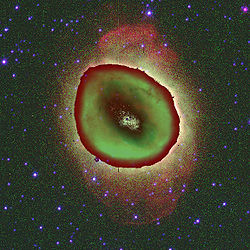 |
NGC 6565 NGC 6565 NGC 6565 is a planetary nebulae located in the constellation Sagittarius.... |
Sagittarius | ||||||
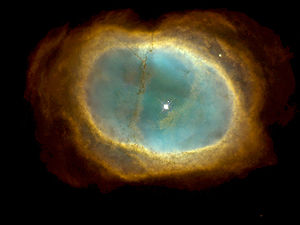 |
Eight-burst Nebula | NGC 3132 NGC 3132 NGC 3132 is a bright and extensively studied planetary nebula in the constellation Vela. Its distance from Earth is estimated at about 550 kpc... |
1888 (prior to) | 2.6 (approx.) | 9.87 | Vela | ||
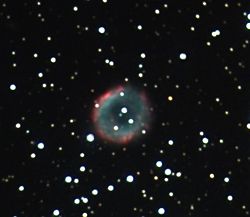 |
NGC 2438 NGC 2438 NGC 2438 is a planetary nebula about 3,000 light years away in the constellation Puppis. It was discovered by William Herschel on March 19, 1786.... |
1786 | 2.9 (approx.) | 11.5 | Puppis | |||
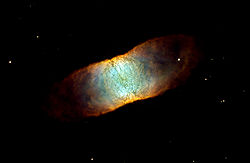 |
Retina Nebula | IC 4406 IC 4406 IC 4406 is a planetary nebula near the western border of the constellation Lupus, the Wolf. It has dust clouds and has the shape of a torus. Despite this, it looks somewhat rectangular because it is seen from its side as viewed from Earth, almost in the plane of its equator.-Structure:IC 4406 is... |
1888-1907 | 2.0 (approx.) | Lupus | |||
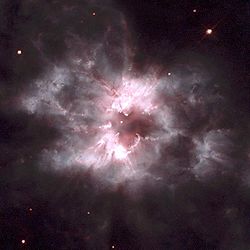 |
NGC 2440 NGC 2440 NGC 2440 is a planetary nebula, one of many in our galaxy. Its central star, HD62166, is possibly the hottest known white dwarf. The nebula is situated in the Puppis constellation.It was discovered by William Herschel on March 4, 1790... |
1790 | 3.6 (approx.) | 9.3 | Puppis | |||
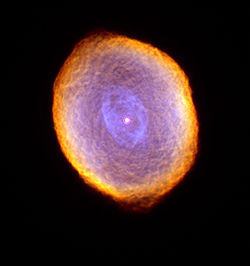 |
Spirograph Nebula | IC 418 IC 418 IC 418, also known as Spirograph Nebula, is a planetary nebula in the Milky Way Galaxy.The name derives from the intricate pattern of the nebula, which resembles a pattern which can be created using the Spirograph, a toy which produces geometric patterns on paper.- History :Only a few million... |
1888-1894 | 1.3 (approx.) | 9.6 | Lepus | ||
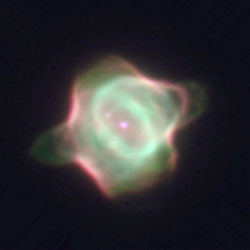 |
Stingray Nebula Stingray Nebula The Stingray Nebula is the youngest known planetary nebula . The Stingray is located in the direction of the southern constellation... |
Hen 3-1357 | 1989 | 18 (approx.) | 10.75 | Ara | ||
| Spiral Planetary Nebula | NGC 5189 NGC 5189 NGC 5189 is a planetary nebula in the constellation Musca. It was discovered by John Herschel in 1835. Seen through the telescope it seems to have an S shape, reminiscent of a barred spiral galaxy. NGC 5189 is symmetrical and is estimated to be 3,000 light years away from Earth. -External links:**... |
1835 | 2.6 (approx.) | 9.5 | Musca | |||
| Mz 1 Mz 1 Mz 1 , is a bipolar planetary nebula in the constellation Norma.-Characteristics:Menzel 1 is a bright PN that has a prominent central ring of enhanced emission. One model of its structure is a 3 dimensional hour-glass shape with a smoothly decreasing density starting from the waist or equator as... |
1922 | 3.4 ± 0.5 | 12.0 | Norma | ||||
| Ant Nebula | Mz 3 | 1922 | 8.0 (approx.) | 13.8 | Norma | |||
| Shapley 1 Shapley 1 Shapley 1 is an annular planetary nebula in the constellation of Norma with a magnitude of +12.6. As viewed from Earth, it is peculiar in that it seems to be a non-bipolar, torus-shaped planetary nebula.... |
PLN 329+2.1 | 1936 | ~1 | 12.6 | Norma | |||
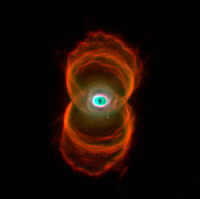 |
Hourglass Nebula Hourglass Nebula The Engraved Hourglass Nebula is a young planetary nebula situated in the southern constellation Musca about 8,000 light-years away from Earth. It was discovered by Annie Jump Cannon and Margaret W. Mayall during their work on an extended Henry Draper Catalogue... |
MyCn18 | 1996 | 8.0 (approx.) | 13.0 | Musca | ||
| NGC 3918 NGC 3918 NGC 3918 is a bright planetary nebula in the constellation Centaurus, that is called the "Blue Planetary" or "The Southerner". It is the brightest of the far southern planetary nebulae. This nebula was discovered by Sir John Herschel in March 1834, and is easily visible through small telescopes... |
1834 | 4.9 | 8.5 | |||||
See also
:Category:Planetary nebulae- List of protoplanetary nebulae
- NebulaNebulaA nebula is an interstellar cloud of dust, hydrogen gas, helium gas and other ionized gases...
- Planetary nebulaPlanetary nebulaA planetary nebula is an emission nebula consisting of an expanding glowing shell of ionized gas ejected during the asymptotic giant branch phase of certain types of stars late in their life...

